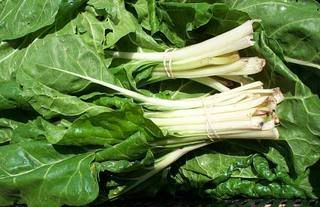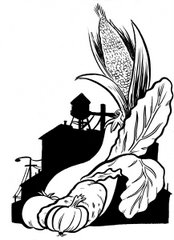This week's share includes peas, a bag of mixed cooking greens, collard greens, and kale. Hector promises that we'll soon have heartier veggies like eggplant and squash, but in the meantime let's rejoice in our green bounty.
I'm turning green. I can't take it! What's the reason I should eat leafy greens again?
According to a fact sheet by the Center for Disease Control, leafy greens are an excellent source of vitamins A and C. (Check out the fact sheet for more in-depth nutritional analysis.)
Vitamin A, also called retinol, helps your eyes adjust to light changes when you come in from outside and also helps keep your eyes, skin and mucous membranes moist. It also has antioxidant properties that neutralize free radicals in the body that cause tissue and cellular damage. (Info from LifeClinic.com)
Vitamin C, also known as ascorbic acid, helps to heal wounds, prevent cell damage, promote healthy gums and teeth, and strengthen the immune system. It also helps the body absorb iron. Recent research has indicated that vitamin C may be associated with delayed aging and disease prevention by destroying 'free radicals'-the molecules associated with aging and cell damage. (Info from LifeClinic.com)
Kale and Collards are rich in calcium. Calcium is one of the main nutrients that the body requires in order to overcome the problems of high blood pressure, heart attack, premenstrual syndrome and colon cancer. Calcium also helps keep bones and teeth strong and healthy. Most people do not have enough calcium in their diet. Bed-Stuy CSA members do not have this problem!
What's new this week?

Swiss Chard is actually the leafy part of a beet that's been grown for its green production. Chard is extremely perishable, so keep refrigerator storage time to a minimum. Store unwashed leaves in plastic bags in the crisper for 2 to 3 days. The stalks can be stored longer if separated from the leaves. Chard packs a huge amount of vitamin A. It is also surprisingly high in other minerals including calcium, iron, magnesium, phosphorus and potassium.
Young tender chard leaves can be eaten raw adding a beet-like flavor to salads and sandwiches. Chard can be used in place of spinach in any recipe, although chard will need to be cooked a bit longer. When cooking older chard, the stems require longer cooking time than the leaves.
What's cooking this week?
Cooking greens can be used pretty much interchangeably in most recipes, though the cooking time may vary according to the thickness of the leaf. For example, if you were using swiss chard in a recipe that originally called for collards, you would reduce the cooking time.
Swiss Chard With Raisins and Pine Nuts
Recipe from Recipezaar.com
Serves 4
- 1 1/2 lbs swiss chard (preferably rainbow or red)
- 1/2 cup pine nuts
- 3 tablespoons olive oil
- 1 medium onion, finely chopped
- 1/4 cup golden raisins, chopped
- 1 cup water
- Tear chard leaves from stems, then coarsely chopped stem and leaves separately.
- Toast pine nuts in a heavy pot over moderate heat, stirring constantly until golden, about 1.5 to 2 minutes.
- Saute onion in oil for about 1 minute, then add chard stems and cook, stirring occasionally for 2 minute.
- Add raisins and 1/2 cup of water and simmer, covered, until stems are softened, about 3 minutes.
- Add chard leaves and remaining 1/2 cup of water and simmer, partially covered until leaves are tender, about 3 minutes. Serve immediately.
Chard Salad Morocco
Recipe from Recipezaar.com.
Serves 4-6
- 1 1/2 to 2 lbs swiss chard, washed, chopped
- 2 tablespoons vegetable oil
- 1 tablespoon minced fresh garlic
- 1 tablespoon paprika
- 2 teaspoons ground cumin
- 2 tablespoons fresh lemon juice
- Boil the chard in salted water until tough stems can be pierced with a fork. Drain, pressing on the chard to squeeze out water.
- Heat the oil in a large skillet and saute the garlic gently until golden. Add the chard, paprika, cumin, lemon juice, salt and pepper to taste and mix well.
- Cook for 5 minutes, stirring occasionally. Let cool. Serve at room temperature or chilled.
Portuguese Kale and Potato Soup
Recipe from CancerProject.org.
Serves 8
- 4 cups water or vegetable broth, divided
- 1 onion, chopped
- 10 garlic cloves, minced
- 1 chipotle pepper in adobo sauce, seeded and finely chopped
- 2 russet potatoes, peeled and chopped
- 1/2 teaspoon salt (optional)
- 4 cups kale (stems removed and finely chopped)
- 1 cup crushed tomatoes or tomato sauce
- 6 ounces Gimme Lean sausage style, or other sausage-style meat substitute
- Heat 1/2 cup water or broth in a large pot and add onion, garlic, and chipotle pepper. Cook over high heat, stirring often, until onion is soft, 3 to 5 minutes.
- Add remaining 3 1/2 cups water or broth, potatoes, and salt, if using. Bring to a simmer, then cover and cook, stirring occasionally, until potatoes are tender when pierced with a knife, about 20 minutes.
- Add kale and crushed tomatoes or tomato sauce. Stir to mix. Cover and cook until kale is tender, about 5 minutes.
- Crumble vegetarian sausage into the soup, stir to mix, and heat until very steamy.
Kale and Toor Dal
Recipe from the Fat-Free Vegan Kitchen.
- 1 cup toor dal* (may substitute red lentils)
- 4 cups water
- 1 bunch kale, washed, center rib removed, and sliced or chopped
- 1 tsp. canola oil
- 1 tsp. cumin seeds
- 1 tsp. black mustard seeds*
- 1 tsp. chopped garlic
- 1/2 tsp. coriander*
- 1/2-1 tsp. red chili pepper or cayenne
- 1/2 tsp. ground cumin*
- 1/8 tsp. fenugreek*
- 1/4 tsp. asafetida*
- 1/8 tsp. freshly ground black pepper
- salt to taste
- Cook the dal in the water until it is soft, about 30-40 minutes. Use a blender or hand blender to completely puree the dal in its water. Set aside.
- In a deep skillet or wok, heat the oil over a medium-hot burner. Add the cumin and mustard seeds and the garlic, and cook for one minute. Add the kale and stir. Add one tablespoon water and cover the pan. Stir every minute or so, and cook until the kale is wilted, about 4 minutes.
- Add the dal and remaining ingredients to the kale. Cover and cook for about 10 minutes. Serve over rice.
Bonus Community News!
Today, Saturday, July 7 12 Noon - 1:30 PM.
Join us for a Swiss Chard Cooking Demo at the stand featuring CSA member and Community Food Educator, Madea.
Now- Sunday, July 8 10 AM- 9PM.
The International African Arts Festival continues at Commodore Barry Park (Navy Street, btw Park and Flushing Avenues). Bed-Stuy CSA friend, Herbal Wysewomon, and Community Food Educator Yonnette Fleming will be among the many merchants selling handmade crafts, internationally traded goods, fine arts, fashion & food from across the Diaspora.

No comments:
Post a Comment